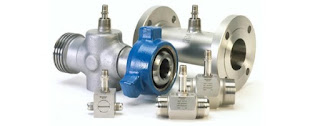Turbine flow meters are
process instruments used in a variety of industrial applications to measure the flow of a fluids. These types of flowmeters operate under the simple principle that the rotation of the turbine will be constant as the turbine is acted upon by a fluid passing through the flowmeter.
Turbine flow meters use the mechanical energy of the fluid to rotate a turbine blade in the flow stream and provide precise and accurate flow measurement. The flow impinging upon the turbine blades causes the rotor to spin. The angular velocity of a turbine flow meter is proportional to flow rate. The rotational velocity of the turbine is interpreted as an electrical frequency output through the use of magnetic pick-ups. As each turbine blade passes by the magnetic pick-up coil, a voltage pulse is generated which is a measure of the flow rate. The total number of pulses gives a measure of the total flow which can be totalized with a maximum error of a single pulse.
The relationship of the angle of the turbine meter blades to the flow stream governs the angular velocity and the output frequency of the meter. The sharper the angle of the turbine blade, the higher the frequency output.
Easy to maintain while also boasting reliability, turbine flow meters are known to be cost-effective solutions that make an ideal device for measuring flow rate. Aside from excellent rangeability, they also provide high response rate and high accuracy compared to other available types of flow meters. Turbine flow meters are sturdy, need very little maintenance, and seldom exhibit much deviation in performance.
These meters are used in multiple industries to reliably measure the velocity of a variety of liquids, gases and vapors over a very broad range of flow rates, temperatures, and viscosities. Turbine flow meters are used to provide measurement information in
cryogenic applications, crude oil production, chemical processing, blending systems, storage, off-loading, product loading, and many other applications across many industries.
Advantages:
- Accuracy
- Excellent repeatability and range
- External power not required
- Good fro cryogenic applications
- Good for extreme pressures and temperatures
- Easy to install
Disadvantages
- Material availability
- Not recommended for contaminated media or slurries
- Error due to wear
For information on any flow control application,
contact Swanson Flo by
calling 800-288-7926 or visit
https://swansonflo.com.





